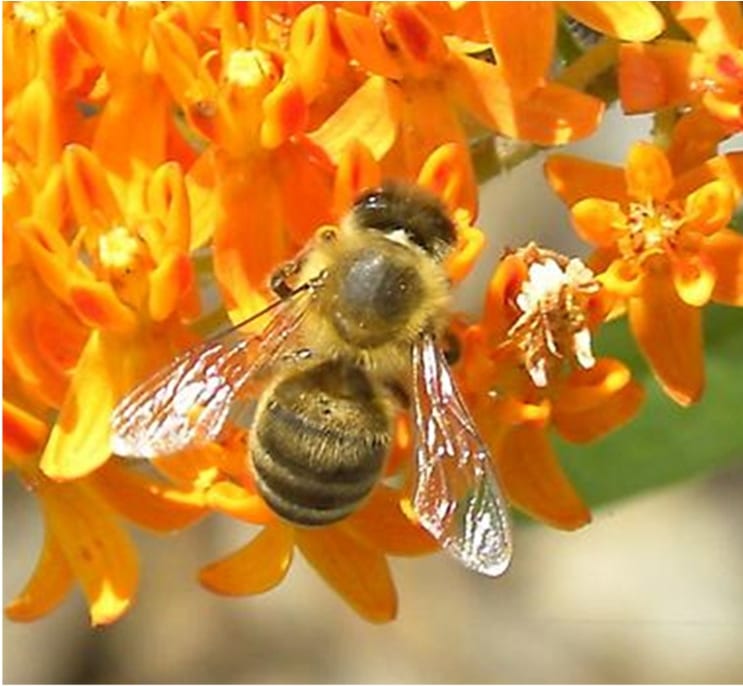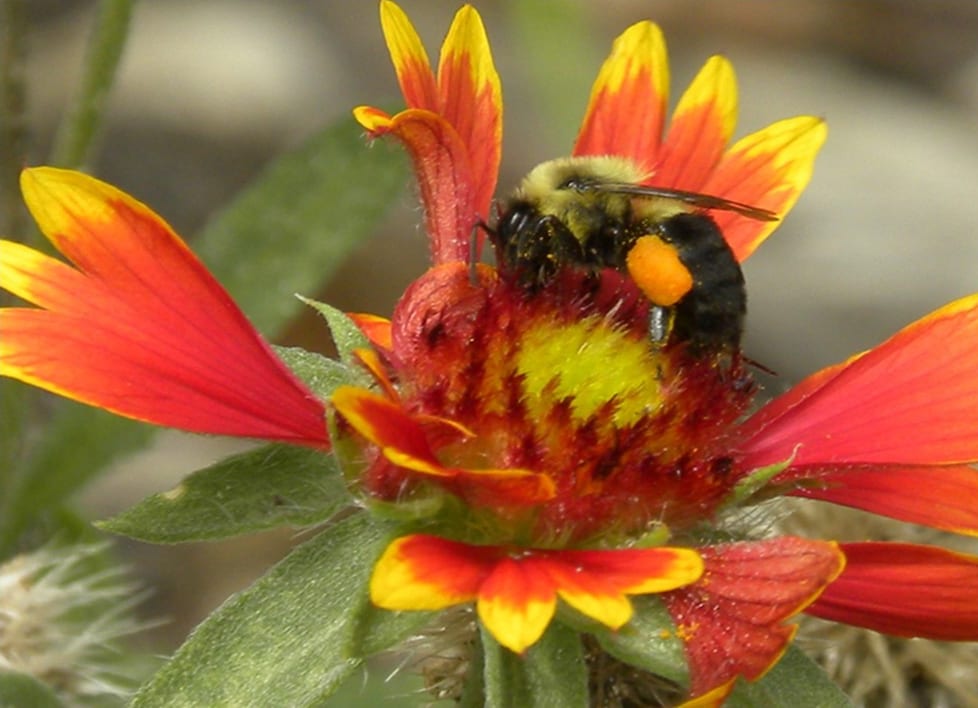by Ashley M. Dow, Claudia L. Jolls, and Rob Davis
Declining pollinator populations and the loss of their ecosystem services are well-documented. We need impactful conservation measures that can help resolve this problem. Solar farms may be a part of a solution that is beneficial to both wildlife and humans.
Increasingly, solar farms are establishing pollinator habitat with diverse mixes of native and other non-invasive plants, even including restoration of meadows in the upper Midwest (MNDNR 2016). Landscaping with native and other non-invasive flowering plants on solar farms has many potential benefits for the solar industry as well as surrounding ecosystems and communities. Notably, establishing habitat with flowering plants, as an alternative to turf, can reduce site preparation and long-term maintenance costs, reduce on-site erosion, and improve local water quality (Semeraro et al. 2018). Healthy, diverse pollinator populations also can increase crop production and stability (Klein et al. 2007). In particular, native plants selected for restoration efforts should be diverse and offer ample pollen and nectar resources to maximize species diversity and benefits for pollinators (Harmon-Threatt and Chin 2016). Yet, we lack important knowledge of how native plants will perform on solar farms and of their use by pollinators.
The goal of our research is to provide more information to solar farm landscape designers and managers about native plant response to shaded conditions and pollinator attractiveness, particularly in the eastern coastal plain of North Carolina. North Carolina already has more than 30,000 acres of ground-mounted photovoltaic solar sites around the state and will double this number within the next five years. Anecdotal evidence suggests that most of these acres were seeded in shallow-rooted turfgrass, which provides little to no pollinator value and is more vulnerable to droughts and downpours.
Selecting Plants for Shade
For our study, we selected 13 shade-tolerant perennial forbs for possible use by pollinators on solar farms. Selection was based on known pollinator use, maximum height (to minimize contact with panels), and nursery availability of seed and plants. We asked how seeds of these selected natives would germinate under shading by solar panels using 90% shade cloth in sub-irrigated pots in a greenhouse experiment. Not all taxa had high germinability under these greenhouse conditions (e.g., Aquilegia canadensis (red columbine), Chrysogonum virginianum (green and gold), Coreopsis lanceolata (lanceleaf tickseed), Gaillardia pulchella (Indian blanket), Geranium maculatum (spotted geranium), Phlox divaricata (wild blue phlox). However, Asclepias tuberosa (butterfly milkweed), Conoclinium coelestinum (blue mistflower), Echinacea purpurea (purple coneflower), Marshallia obovata (Barbara’s buttons), Rudbeckia fulgida (orange coneflower), Rudbeckia hirta (black-eyed Susan), and Stokesia laevis (Stokes’ aster) germinated successfully (in excess of 50-70%), even under 90% shade. Preliminary data suggest that field germination is considerably reduced, however.
We also asked how attractive these native plants are to pollinating insects. With support from Bayer CropScience Feed A Bee™ program and East Carolina University, landscaped beds were established on campus in October 2017 as replicated 1.2 m x 1.8 m plots. We planted 16 native plant species in each plot: one each of 11 selected native forbs (excluding A. canadensis and G. maculatum due to low germinability and plot size limitations), two native graminoids [Rhynchospora colorata (white star sedge) and Chasmanthium latifolium (Indian woodoats)], and three flowering shrubs [Eubotrys racemosa (swamp doghobble), Ilex glabra (inkberry), and Rhododendron catawbiense (catawba rosebay)]. On 20 occasions from May to September 2018, each of the 24 – 1.2 m x 1.8 m plots were observed for 10 min intervals, randomly selected for sequence of observation, except when there were no flowers present, for a total of 72 hours. This time frame was chosen for peak anticipated insect activity. All native forbs in these plots (except wild blue phlox, which flowered prior to our observation period) were evaluated for pollinator attractiveness.
Keeping Count of Pollinators
We used a visitation index of visits per floral unit (individual flower or head for Asteraceae) to assess attractiveness (Table 1). Stokes’ aster, lanceleaf tickseed, and Indian blanket were most frequently visited by known insect pollinators (Table 1). Collectively, these native plants attracted at least 37 species of insects, including the monarch butterfly. Interestingly, Rhynchospora colorata inflorescences were also visited by pollinating insects and may be an additional pollinator resource. The plant species green and gold, orange coneflower, Indian blanket, and black-eyed Susan had the most diverse appeal, each attracting potential pollinators from eight different genera. These native plants show promise for landscaping on solar farms and promotion of pollinator habitat.
This and related work on native non-invasive plant cultivation and insect use is necessary to support the use of flowering plants in pollinator habitat restoration. A remaining challenge for the solar industry may be the need to make an early commitment to flowering landscapes, e.g., to place seed orders in advance instead of scrambling after construction is complete and ending up with turf. Concomitantly, the nursery industry also needs to keep pace with increasing demand for native and non-invasive flowering mixes. Ultimately, advances in these areas can help landscape managers make changes in seed mix design and management practices in order to meaningfully benefit native pollinators, within the operating constraints of a solar farm.
Table 1: Performance of 10 native plant species ranked by floral units produced, visits by insects, and visitation index (V/F = number of insect visits per floral unit).
| Plant Species | Rank of Flower Production | Rank of Insect Visits | Visitation Index (V/F) Rank |
| Stokesia laevis | 10 | 10 | 1 |
| Coreopsis lanceolata | 7 | 4 | 2 |
| Gaillardia pulchella | 6 | 5 | 3 |
| Asclepias tuberosa | 4 | 3 | 4 |
| Rudbeckia fulgida | 2 | 1 | 5 |
| Marshallia obovata | 9 | 6 | 6 |
| Chrysogonum virginianum | 1 | 2 | 7 |
| Echinacea purpurea | 5 | 6 | 8 |
| Rudbeckia hirta | 8 | 9 | 9 |
| Conoclinium coelestinum | 3 | 7 | 10 |
Literature Cited
Harmon-Threatt, A., Chin, K. 2016. Common methods for tallgrass prairie restoration and their potential effects on bee diversity. Natural Areas Journal 36, 400-411.
Klein, A.M., Vaissière, B.E., Cane, J.H., Steffan-Dewenter, I., Cunningham, S.A., Kremen, C., Tscharntke, T. 2007. Importance of pollinators in changing landscapes for world crops. Proceedings of the Royal Society B 274, 303-313.
Minnesota Department of Natural Resources (MNDNR). 2016. Prairie establishment and maintenance technical guidance for commercial solar projects. Minnesota Legislative Reference Library. Department of Natural Resources. New Ulm, Minnesota. pp. 13.
Semeraro, T, Pomes, A., Del Guidice, C., Negro, D., Aretano, R. 2018. Planning ground-based utility scale solar energy as green infrastructure to enhance ecosystem services. Energy Policy 117, 218-227.
About the Authors
Ashley M. Dow Ashley M. Dow received her B.S. in Biology from East Carolina University in 2008, where she is currently a Master of Science candidate. She is interested in native plant conservation with a current research focus on native plant pollinator habitat for solar farms in North Carolina.
Claudia L. Jolls is a professor and Assistant Chair in the Department of Biology at East Carolina University. Her research in plant ecology centers on critical biological knowledge for conservation of biodiversity, particularly rare plants, pollinators, and use of native plants for landscaping.
Rob Davis is director of Center for Pollinators in Energy at Fresh Energy, an independent policy nonprofit. His work on pollinator-friendly solar has been featured in trainings by the U.S. Department of the Interior, the U.S. Department of Energy, and the North Carolina Clean Energy Technology Center.
***
Each author appearing herein retains original copyright. Right to reproduce or disseminate all material herein, including to Columbia University Library’s CAUSEWAY Project, is otherwise reserved by ELA. Please contact ELA for permission to reprint.
Mention of products is not intended to constitute endorsement. Opinions expressed in this newsletter article do not necessarily represent those of ELA’s directors, staff, or members.







